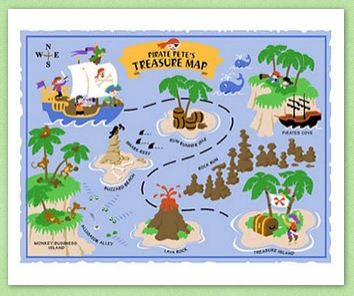SLP Corner: Who Do We Ask When We Don’t Know Which Way to Go?
By: Kelly Ring-Whiklo, M.Sc., S-LP ( C )
Reprinted with the express permission of the author as it originally appeared on her blog.
Whether you are planning a trip this summer or staying close to home, are lots of ways to use maps to develop communication skills.
The age of your child, their interests, and the activities you are planning will help you decide what kinds of maps will work best. For younger children very simple maps with pictures and a few details are best. Older children will enjoy maps with more detail and information.
Here are a few ideas of different maps you can buy, get free and/or online, or make:
- Road maps
- Maps of local landmarks or attractions
- Store maps
- Think about the departments of your local grocery store, or maps of the shopping mall
- Maps of your community
- Include stores, fire halls, police stations, restaurants, parks, homes of friends and family
- Maps of your yard or home
- Treasure maps
- Hide some treasure in a designated area, such as your yard, neighbourhood, or a park. Use a map to find the treasure. Or, instead of hiding treasure, use the map to go on a scavenger hunt.
- Another fun way to treasure hunt is by geocaching
Goal: Sequencing skills (putting events in order)
Plan a route for your trip together, whether it’s a cross-country road trip, running errands, or the path you’ll take around the grocery store. Talk about where you will go first, second, next, last.
Goal: Explaining and describing
Take turns giving each other directions. Use location words like left, right, beside, across, in front, behind. Describe the landmarks along the way, like the buildings (or produce) you will pass. Give each other clues to see if the other one can guess where to turn, cross, or stop.
Goal: Listening skills
Draw a map without letting the other see. Take turns describing the map and have the other draw it based on the description. See if your maps match each other. Give your child directions to follow to different locations. Be sure to give just one or two steps at a time, letting them finish each direction before continuing.
Goal: Community Vocabulary
Learn about your community services together. Think about stores, fire stations, police stations, libraries, stores and restaurants. Talk about the function of each service, the jobs of the people who work there, and what they wear. Talk about where the services are located (and in relation to each other) and describe the buildings. Take pictures, or draw pictures to include on a giant map, or in a scrapbook with the map of your community.
Goal: Speech Sounds
Try any of the activities above, but focus on words and sentences with your child’s target sounds in them.
Goal: Fluency
Try any of the activities above, but focus on having your child use their fluency strategies.
Featured Guest Blogger: Kelly Ring-Whiklo, M.Sc., S-LP ( C )
I am a speech-language pathologist living near Winnipeg, Manitoba. Since graduating with my Master of Science in Speech-Language Pathology in 1999, I have worked in public schools in Oregon and Manitoba. My private practice, Prairie Speech & Language, serves children birth to 18 years of age.
PediaStaff is Hiring!
All JobsPediaStaff hires pediatric and school-based professionals nationwide for contract assignments of 2 to 12 months. We also help clinics, hospitals, schools, and home health agencies to find and hire these professionals directly. We work with Speech-Language Pathologists, Occupational and Physical Therapists, School Psychologists, and others in pediatric therapy and education.

